Intel Xeon E Six-Core Review: E-2186G, E-2176G, E-2146G, and E-2136 Tested
by Ian Cutress on November 5, 2018 12:00 PM EST- Posted in
- CPUs
- Intel
- Xeon
- Enterprise CPUs
- Xeon E
CPU Performance: Rendering Tests
Rendering is often a key target for processor workloads, lending itself to a professional environment. It comes in different formats as well, from 3D rendering through rasterization, such as games, or by ray tracing, and invokes the ability of the software to manage meshes, textures, collisions, aliasing, physics (in animations), and discarding unnecessary work. Most renderers offer CPU code paths, while a few use GPUs and select environments use FPGAs or dedicated ASICs. For big studios however, CPUs are still the hardware of choice.
All of our benchmark results can also be found in our benchmark engine, Bench.
Corona 1.3: Performance Render
An advanced performance based renderer for software such as 3ds Max and Cinema 4D, the Corona benchmark renders a generated scene as a standard under its 1.3 software version. Normally the GUI implementation of the benchmark shows the scene being built, and allows the user to upload the result as a ‘time to complete’.
We got in contact with the developer who gave us a command line version of the benchmark that does a direct output of results. Rather than reporting time, we report the average number of rays per second across six runs, as the performance scaling of a result per unit time is typically visually easier to understand.
The Corona benchmark website can be found at https://corona-renderer.com/benchmark
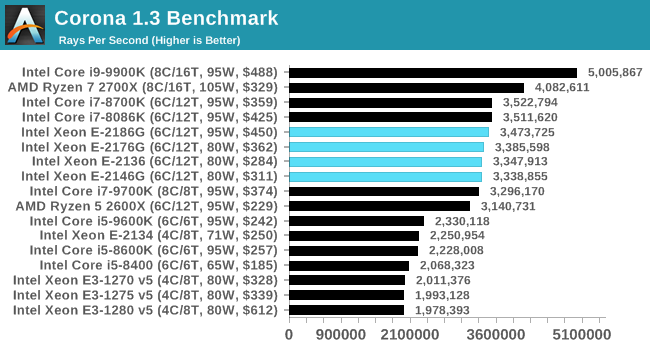
Blender 2.79b: 3D Creation Suite
A high profile rendering tool, Blender is open-source allowing for massive amounts of configurability, and is used by a number of high-profile animation studios worldwide. The organization recently released a Blender benchmark package, a couple of weeks after we had narrowed our Blender test for our new suite, however their test can take over an hour. For our results, we run one of the sub-tests in that suite through the command line - a standard ‘bmw27’ scene in CPU only mode, and measure the time to complete the render.
Blender can be downloaded at https://www.blender.org/download/
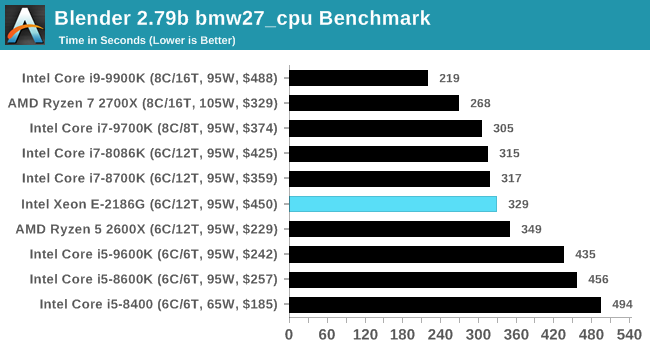
We had a small issue with Blender - after installing Intel IGP drivers, this version didn't want to work. We'll run through the tests that were affected when time permits.
LuxMark v3.1: LuxRender via Different Code Paths
As stated at the top, there are many different ways to process rendering data: CPU, GPU, Accelerator, and others. On top of that, there are many frameworks and APIs in which to program, depending on how the software will be used. LuxMark, a benchmark developed using the LuxRender engine, offers several different scenes and APIs.
Taken from the Linux Version of LuxMark
In our test, we run the simple ‘Ball’ scene on both the C++ and OpenCL code paths, but in CPU mode. This scene starts with a rough render and slowly improves the quality over two minutes, giving a final result in what is essentially an average ‘kilorays per second’.
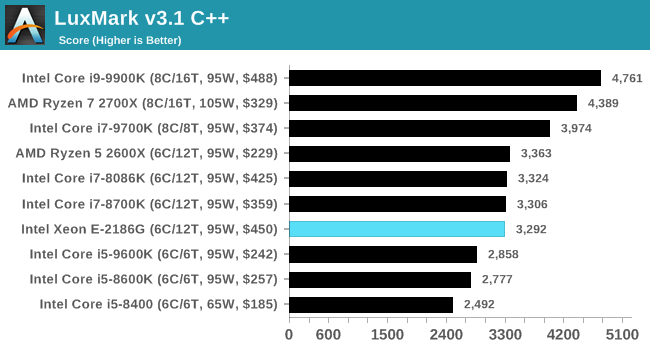
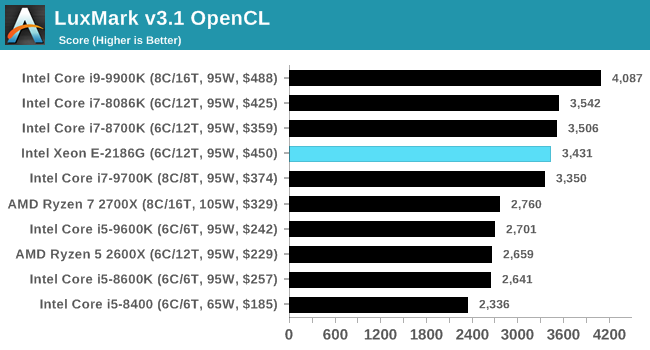
POV-Ray 3.7.1: Ray Tracing
The Persistence of Vision ray tracing engine is another well-known benchmarking tool, which was in a state of relative hibernation until AMD released its Zen processors, to which suddenly both Intel and AMD were submitting code to the main branch of the open source project. For our test, we use the built-in benchmark for all-cores, called from the command line.
POV-Ray can be downloaded from http://www.povray.org/
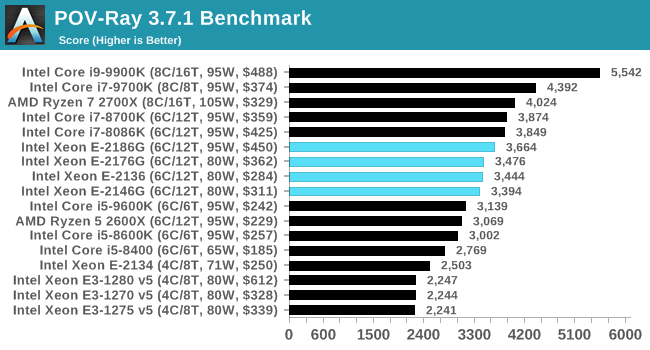












48 Comments
View All Comments
bolkhov - Friday, November 9, 2018 - link
Yes it does.72 for ECC vs. 64 for non-ECC.
notb - Wednesday, November 7, 2018 - link
Go ask your IT department if Ryzen's ECC "support" passes their security policy. :-)twtech - Sunday, November 18, 2018 - link
Most IT departments don't build their own systems. They'll standardize with something like Dell or HP, and maybe do things like RAM/HDD upgrades, etc.The cost of the CPU in a system is usually a relatively small cost compared to the overall total. Support costs can dwarf initial purchase costs. The more that a company can standardize their hardware, the easier it is to maintain it.
For example, IT may want to test patches before letting them be applied across the organization. If, in an ideal scenario, every system was exactly the same, then potentially only one test would be needed to make sure it works properly.
Of course that often won't be possible, but the closer they can remain to that ideal, the better.
HStewart - Monday, November 5, 2018 - link
To me it looks like AVX 512 gets a whopping 44% ( ~ 5200 / 3600 ) increase on similar equip similar CPU. It would be nice to see same cpu with and without AVX 512 enabled test.osrk - Monday, November 5, 2018 - link
FYI provantage told me they were getting in their shipment Nov 12. I have one on pre order.Dr_b_ - Monday, November 5, 2018 - link
Have my 2186G on pre-order with them as well, for over a month now. Already have the 64GB ECC UDIMMs and Asus C-246 Pro board just waiting. IMHO, the biggest let down with the Asus board is that it doesn't have USB 3.1 2.0 header on the motherboard. Have inquiry with Asus about support for 9900K CFL-R CPU's haven't heard back yet.mooninite - Tuesday, November 13, 2018 - link
Did you get yours shipped out yet? Websites are still showing either "out of stock" or "special order" for these Xeons.osrk - Friday, November 16, 2018 - link
No. They've had them in and out of stock. If you pre-ordered and the item comes in stock for even a penny more your item will not be shipped. They will only fulfill your order when the item comes into stock for the amount you paid. This has left a very bad taste in my mouth when ordering with Provantage and I'm likely not going to order from them again.For example the E-2176G was in stock with them for $1 more than I paid. Did they ship it or notify me that I could pay the extra $1 and have it ship? Nope. I'm writing up my experiences with them on the ratings site.
Dragonstongue - Monday, November 5, 2018 - link
wonder how much of these things tested are "biased" towards making Intel look as "rosy" as possible to steer away any shortcomings.. I would imagine they have very specific test methodology to ensure "weakness" are not shown.. Probably will never happen, but it would be real nice if "everyone" raced on the same track sort of speak so the best "car" wins, not because other "cars" are hobbled by illegitimate tactics.AnnoyedGrunt - Tuesday, November 6, 2018 - link
Yes, I suspect that Anandtech opened the "hood" on the AMD "cars" and drained their "blinker fluid" and damaged their "muffler bearings" so they couldn't "race" as well.I'd go on, but I ran out of quotation marks.
-AG